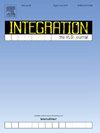High-performance CORDIC-based approximate MAC architectures for FPGA platforms
IF 2.2
3区 工程技术
Q3 COMPUTER SCIENCE, HARDWARE & ARCHITECTURE
引用次数: 0
Abstract
CORDIC is a versatile algorithm frequently used in different signal-processing operations. While using CORDIC-based computations in evaluating trigonometric and transcendental functions is quite prevalent, the resource overhead associated with its implementation does not justify its use in evaluating linear functions like multiplication and addition. However, with the emergence of approximate computing as an attractive paradigm for error-resilient applications, the algorithm can be used to design approximate linear computational units that completely justify the accuracy-performance trade-offs. In this paper, we model the CORDIC-based computations to emulate the multiply-accumulate operation, albeit with some loss of accuracy. We specifically present two incremental CORDIC-based multiply-accumulate architectures with an attempt to improve the accuracy-performance trade-offs with each increment. A detailed Pareto analysis for 8 and 16-bit unsigned and signed multiply-accumulate structures is conducted to determine the optimum number of computing stages and the associated bit-precision of the intermediate results. Accuracy and performance analysis using 6th and 7th generation FPGAs reveals a substantial improvement over state-of-the-art designs. The proposed architectures are also tested using three image processing applications, and the output results are promising.
求助全文
约1分钟内获得全文
求助全文
来源期刊

Integration-The Vlsi Journal
工程技术-工程:电子与电气
CiteScore
3.80
自引率
5.30%
发文量
107
审稿时长
6 months
期刊介绍:
Integration''s aim is to cover every aspect of the VLSI area, with an emphasis on cross-fertilization between various fields of science, and the design, verification, test and applications of integrated circuits and systems, as well as closely related topics in process and device technologies. Individual issues will feature peer-reviewed tutorials and articles as well as reviews of recent publications. The intended coverage of the journal can be assessed by examining the following (non-exclusive) list of topics:
Specification methods and languages; Analog/Digital Integrated Circuits and Systems; VLSI architectures; Algorithms, methods and tools for modeling, simulation, synthesis and verification of integrated circuits and systems of any complexity; Embedded systems; High-level synthesis for VLSI systems; Logic synthesis and finite automata; Testing, design-for-test and test generation algorithms; Physical design; Formal verification; Algorithms implemented in VLSI systems; Systems engineering; Heterogeneous systems.
 求助内容:
求助内容: 应助结果提醒方式:
应助结果提醒方式:


